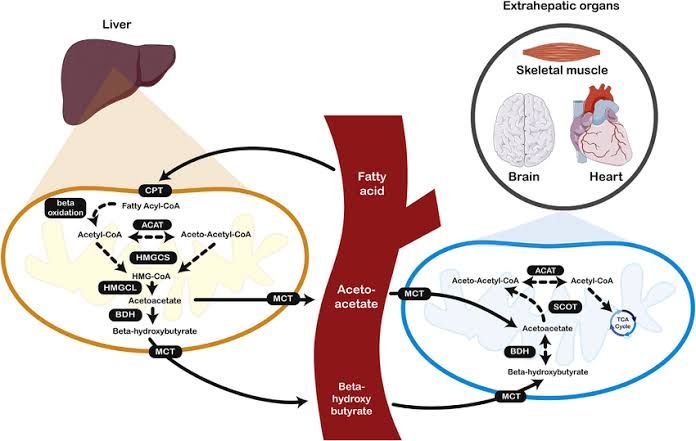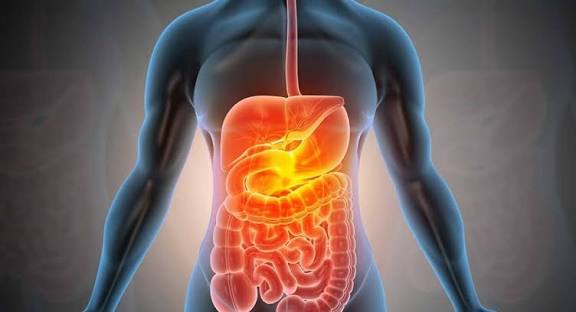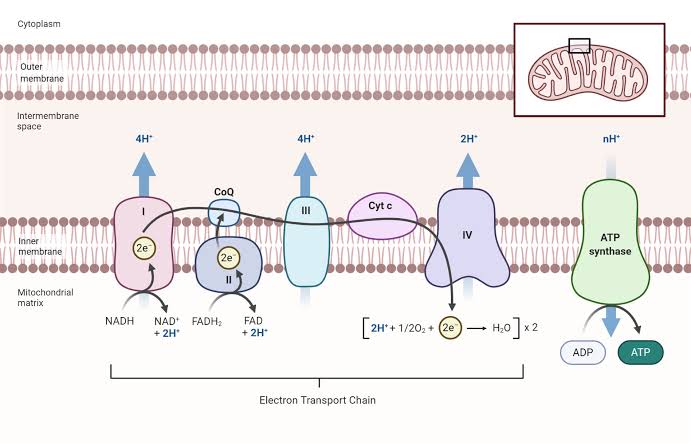
Ketone Bodies and Their Formation
Ketone bodies are water-soluble molecules produced by the liver during periods of low carbohydrate availability. They serve as an alternative energy source for various tissues, particularly during prolonged fasting, starvation, or in conditions of insulin deficiency such as diabetes mellitus. The three primary ketone bodies formed in the body are acetoacetate, beta-hydroxybutyrate, and acetone.
1. Acetoacetate (AcAc)
Acetoacetate is the first ketone body synthesized from fatty acids through a process called ketogenesis. It is formed in the mitochondria of liver cells from the breakdown of fatty acids via β-oxidation. When there is a high rate of fatty acid oxidation and low levels of glucose, acetoacetate can be produced in significant amounts. Acetoacetate can be converted into other ketone bodies or used directly by peripheral tissues as an energy source.
2. Beta-Hydroxybutyrate (BHB)
Beta-hydroxybutyrate is not technically a true ketone but is often classified with them due to its role as an energy substrate. It is synthesized from acetoacetate in a reversible reaction catalyzed by the enzyme β-hydroxybutyrate dehydrogenase. This conversion occurs primarily when there are elevated levels of NADH relative to NAD+, which typically happens during states of high fat oxidation and low carbohydrate availability. Beta-hydroxybutyrate serves as a more efficient fuel than acetoacetate because it yields more ATP upon oxidation.
3. Acetone
Acetone is the least abundant and most volatile of the three ketone bodies. It is produced as a spontaneous decarboxylation product of acetoacetate and does not serve as a significant energy source like acetoacetate and beta-hydroxybutyrate do. Instead, acetone is excreted through breath and urine, which can lead to fruity-smelling breath in individuals with elevated ketone levels.
Conditions Leading to Ketogenesis
Ketogenesis occurs under several physiological conditions:
- Fasting or Starvation: During prolonged fasting or starvation, glycogen stores become depleted, leading to increased lipolysis (fat breakdown) and subsequent fatty acid release into circulation. The liver converts these fatty acids into ketones to provide energy for vital organs such as the brain.
- Diabetes Mellitus: In uncontrolled diabetes, particularly Type 1 diabetes, insulin deficiency leads to increased lipolysis and decreased glucose uptake by cells. This results in excessive production of ketones, leading to diabetic ketoacidosis (DKA), a potentially life-threatening condition characterized by high blood sugar levels and metabolic acidosis.
- Low-Carbohydrate Diets: Diets that significantly reduce carbohydrate intake (such as ketogenic diets) promote ketosis as the body adapts to using fat for fuel instead of carbohydrates. This state can enhance fat loss but requires careful management to avoid adverse effects.
- Intense Exercise: Prolonged intense physical activity can also lead to increased fat oxidation and subsequent ketogenesis due to depletion of glycogen stores.
In summary, ketone bodies—acetoacetate, beta-hydroxybutyrate, and acetone—are produced primarily during states where carbohydrate availability is low or when there is increased fat metabolism due to various physiological conditions such as fasting, diabetes mellitus, low-carbohydrate diets, or intense exercise.
Synthesis of Ketone Bodies: Important Steps and Rate Limiting Step
The synthesis occurs through a series of biochemical reactions that convert fatty acids into ketone bodies, which include acetoacetate, beta-hydroxybutyrate, and acetone. Here are the important steps involved in the synthesis of ketone bodies:
1. Mobilization of Fatty Acids
The process begins with the mobilization of fatty acids from adipose tissue. During fasting or carbohydrate restriction, insulin levels decrease while glucagon levels increase. This hormonal change stimulates lipolysis, where triglycerides are broken down into glycerol and free fatty acids (FFAs). The FFAs are then released into the bloodstream.
2. Transport to the Liver
Once released, free fatty acids travel through the bloodstream to the liver. They enter hepatocytes (liver cells) where they undergo further processing.
3. Beta-Oxidation
Inside the liver cells, fatty acids undergo beta-oxidation in the mitochondria. This process involves several enzymatic reactions that break down fatty acids into two-carbon units called acetyl-CoA. Each cycle of beta-oxidation shortens the fatty acid chain by two carbons and produces NADH and FADH2 as byproducts.
4. Formation of Acetyl-CoA
The end product of beta-oxidation is acetyl-CoA, which is crucial for ketogenesis. Under normal circumstances, acetyl-CoA enters the citric acid cycle (Krebs cycle) for energy production; however, during periods of high fatty acid oxidation and low carbohydrate availability, excess acetyl-CoA accumulates.
5. Ketogenesis
The accumulation of acetyl-CoA triggers ketogenesis in the mitochondria of liver cells:
- Condensation: Two molecules of acetyl-CoA condense to form acetoacetyl-CoA.
- Formation of HMG-CoA: Acetoacetyl-CoA then reacts with another molecule of acetyl-CoA to form 3-hydroxy-3-methylglutaryl CoA (HMG-CoA).
- Cleavage: HMG-CoA is then cleaved by HMG-CoA lyase to produce acetoacetate and acetyl-CoA.
- Reduction to Beta-Hydroxybutyrate: Acetoacetate can be converted into beta-hydroxybutyrate through a reduction reaction catalyzed by beta-hydroxybutyrate dehydrogenase.
- Spontaneous Decarboxylation: Some acetoacetate can spontaneously decarboxylate to form acetone, which is volatile and excreted via breath.
Rate Limiting Step
The rate-limiting step in ketone body synthesis is often considered to be the conversion of HMG-CoA to acetoacetate by HMG-CoA lyase. This step regulates how much acetoacetate is produced from HMG-CoA and thus controls overall ketogenesis.
In summary, ketone body synthesis involves mobilization and transport of fatty acids to the liver, their conversion into acetyl-CoA via beta-oxidation, followed by a series of reactions leading to the formation of acetoacetate and its derivatives. The key regulatory point in this pathway is at HMG-CoA lyase activity.
Utilization of Ketone Bodies and Organs Involved
Step 1: Production of Ketone Bodies
The process begins in the liver through a series of biochemical reactions known as ketogenesis. This occurs primarily in the mitochondria of liver cells (hepatocytes) and involves the following steps:
- Fatty Acid Mobilization: During fasting or low-carbohydrate intake, adipose tissue breaks down triglycerides into free fatty acids (FFAs) and glycerol. FFAs are released into the bloodstream.
- Beta-Oxidation: FFAs are transported to the liver where they undergo beta-oxidation, a metabolic process that breaks down fatty acids into acetyl-CoA units.
- Ketogenesis: Acetyl-CoA is then converted into ketone bodies through several enzymatic reactions:
- Two molecules of acetyl-CoA combine to form acetoacetate.
- Acetoacetate can be reduced to beta-hydroxybutyrate or spontaneously decarboxylated to form acetone.
This production typically increases significantly during states of fasting or carbohydrate restriction.
Step 2: Transport of Ketone Bodies
Once synthesized, ketone bodies enter the bloodstream and circulate throughout the body. They are soluble in water, which allows them to be easily transported without requiring carrier proteins like fatty acids do.
Step 3: Utilization by Organs
Various organs utilize ketone bodies for energy:
- Brain: The brain is a significant consumer of ketone bodies during prolonged fasting or starvation when glucose availability is limited. It can utilize acetoacetate and beta-hydroxybutyrate effectively, providing up to 70% of its energy needs in these states.
- Muscle Tissue: Skeletal muscles can use ketones during prolonged exercise or fasting. They preferentially utilize beta-hydroxybutyrate due to its higher energy yield compared to glucose under certain conditions.
- Heart Muscle: The heart is highly efficient at using ketone bodies as fuel, particularly beta-hydroxybutyrate, which provides a substantial portion of its energy requirements during periods of increased fatty acid oxidation.
- Kidneys: The renal cortex can also utilize ketones for energy production, especially during states of metabolic stress when glucose is scarce.
- Other Tissues: Other tissues such as the intestines and certain types of epithelial cells can also metabolize ketones but to a lesser extent than those mentioned above.
Step 4: Conversion Back to Acetyl-CoA
Once inside these tissues, ketone bodies undergo conversion back into acetyl-CoA through specific enzymes:
- Beta-hydroxybutyrate is oxidized back to acetoacetate.
- Acetoacetate is then activated by succinyl-CoA acetoacetate CoA transferase (also known as thiophorase) to form acetoacetyl-CoA.
- Acetoacetyl-CoA can then be split into two molecules of acetyl-CoA via thiolase enzyme action, entering the Krebs cycle for ATP production.
This conversion allows cells to efficiently generate ATP from ketones when glucose levels are low.
Conclusion
In summary, ketone bodies serve as an essential alternative energy source during periods when carbohydrates are limited. Their production in the liver and utilization by various organs such as the brain, muscles, heart, and kidneys highlight their critical role in maintaining energy homeostasis under metabolic stress conditions.
Pathogenesis of Diabetic Ketoacidosis
Diabetic ketoacidosis (DKA) is a serious complication primarily associated with type 1 diabetes mellitus, although it can also occur in type 2 diabetes under certain conditions. The pathogenesis of DKA involves several interrelated metabolic derangements:
- Insulin Deficiency: DKA typically arises due to an absolute or relative deficiency of insulin. This deficiency can be precipitated by factors such as infection, stress, inadequate insulin therapy, or new-onset diabetes.
- Increased Counterregulatory Hormones: In the absence of sufficient insulin, counterregulatory hormones such as glucagon, cortisol, epinephrine, and growth hormone increase. These hormones promote gluconeogenesis and glycogenolysis in the liver, leading to elevated blood glucose levels.
- Lipolysis and Ketogenesis: Insulin normally inhibits lipolysis; however, its deficiency leads to increased breakdown of triglycerides into free fatty acids (FFAs). The liver converts these FFAs into ketone bodies (acetoacetate and β-hydroxybutyrate) through a process called ketogenesis. The accumulation of these ketone bodies results in metabolic acidosis.
- Metabolic Acidosis: The increased production of ketone bodies overwhelms the buffering capacity of the blood and tissues, leading to a decrease in blood pH (acidosis). This is characterized by a low bicarbonate level and an increased anion gap.
- Dehydration and Electrolyte Imbalance: High blood glucose levels lead to osmotic diuresis, resulting in significant fluid loss and dehydration. This loss is compounded by vomiting that often accompanies DKA. Electrolyte imbalances occur due to both renal losses and shifts in body compartments; potassium levels may initially appear normal or high but can drop significantly during treatment.
Clinical Presentation
The clinical presentation of DKA is characterized by a classic triad:
- Hyperglycemia: Blood glucose levels are typically greater than 250 mg/dL (13.9 mmol/L), often exceeding 500 mg/dL (27.8 mmol/L).
- Ketoacidosis: Patients present with symptoms related to acidosis including nausea, vomiting, abdominal pain, and altered mental status ranging from confusion to coma.
- Dehydration: Signs include dry mucous membranes, tachycardia, hypotension, and decreased skin turgor.
Additional symptoms may include:
- Fruity odor on breath due to acetone
- Kussmaul respirations (deep labored breathing)
- Polyuria and polydipsia
Laboratory findings confirm the diagnosis:
- Arterial blood gas analysis shows metabolic acidosis with an elevated anion gap.
- Serum electrolytes reveal hyperkalemia initially but may show hypokalemia after treatment begins.
- Urinalysis may show glycosuria and ketonuria.
Management
The management of DKA involves several critical steps aimed at correcting metabolic derangements:
- Fluid Resuscitation: Initial treatment includes intravenous fluids to restore volume status and correct dehydration. Isotonic saline (0.9% NaCl) is typically used initially; once serum sodium levels normalize or if hypernatremia occurs, hypotonic fluids like half-normal saline (0.45% NaCl) may be introduced.
- Insulin Therapy: Continuous intravenous insulin infusion is initiated to reduce blood glucose levels effectively while simultaneously suppressing ketogenesis. The goal is to lower blood glucose gradually (by about 50–100 mg/dL per hour).
- Electrolyte Management: Potassium levels must be monitored closely throughout treatment since insulin administration drives potassium back into cells, potentially leading to hypokalemia despite initial hyperkalemia.
- Correction of Acidosis: While bicarbonate therapy is generally not recommended unless severe acidosis (pH < 6.9) is present due to potential complications such as paradoxical cerebral acidosis or hypokalemia.
- Identification and Treatment of Precipitating Factors: It’s crucial to identify any underlying causes such as infections or inadequate insulin therapy that led to the episode of DKA for appropriate management.
- Monitoring: Continuous monitoring of vital signs, mental status changes, laboratory values including glucose levels, electrolytes, arterial blood gases should be performed until stabilization occurs.
- Transitioning Care: Once patients stabilize clinically and biochemically, they can transition back to subcutaneous insulin therapy with careful planning regarding dosing based on their previous regimen or current needs.
In summary:
- Diabetic ketoacidosis results from insulin deficiency leading to hyperglycemia and ketosis.
- Clinically presents with hyperglycemia (>250 mg/dL), metabolic acidosis with an elevated anion gap, dehydration signs.
- Management focuses on fluid resuscitation, insulin therapy for glycemic control, electrolyte monitoring/correction, addressing underlying causes.







